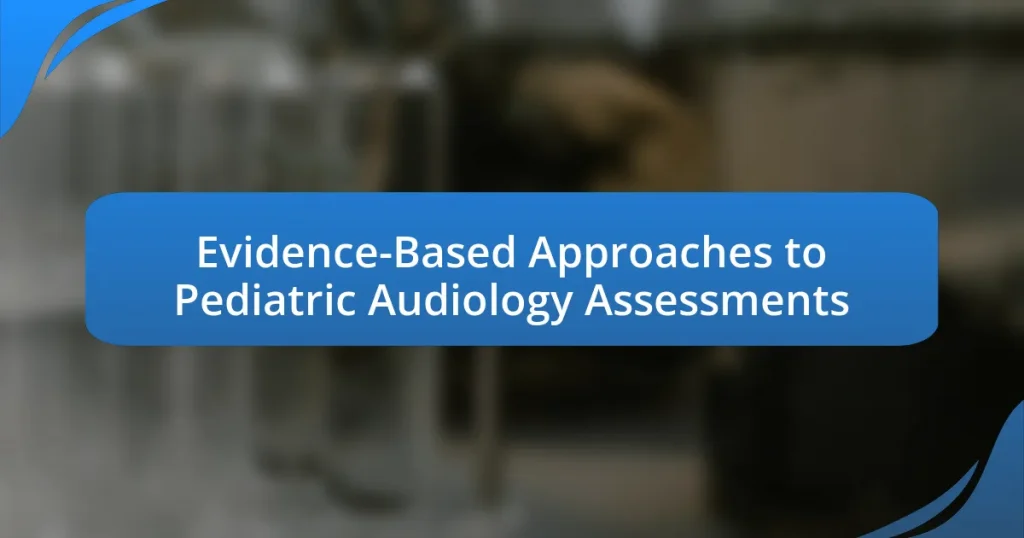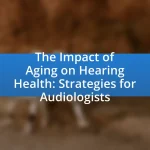Evidence-based approaches to pediatric audiology assessments utilize scientifically validated methods to evaluate hearing in children, particularly infants and young children who cannot provide reliable behavioral responses. Key techniques include auditory brainstem response (ABR) testing and otoacoustic emissions (OAE), which enhance diagnostic accuracy and facilitate early identification of hearing impairments. The article outlines the differences between evidence-based and traditional methods, emphasizing the integration of clinical expertise, patient values, and research evidence. It also discusses common assessment tools, innovative technologies, and the importance of family involvement in the assessment process, ultimately highlighting how these practices improve patient outcomes and the overall quality of care in pediatric audiology.
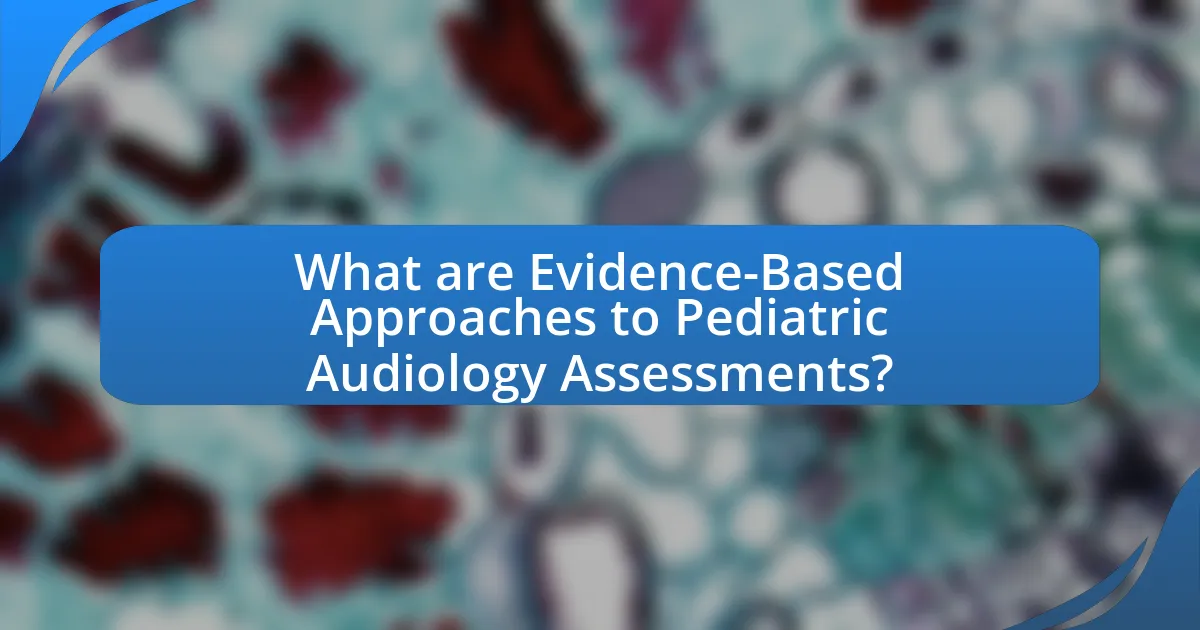
What are Evidence-Based Approaches to Pediatric Audiology Assessments?
Evidence-based approaches to pediatric audiology assessments involve utilizing scientifically validated methods and protocols to evaluate hearing in children. These approaches include the use of objective measures such as auditory brainstem response (ABR) testing and otoacoustic emissions (OAE) to accurately assess hearing abilities, especially in infants and young children who cannot provide reliable behavioral responses. Research indicates that these methods significantly improve the accuracy of hearing assessments, as they are less influenced by subjective factors and can detect hearing loss at earlier stages. For instance, a study published in the Journal of the American Academy of Audiology demonstrates that incorporating ABR and OAE in routine screenings leads to earlier identification of hearing impairments, which is crucial for timely intervention and support.
How do evidence-based approaches differ from traditional methods in pediatric audiology?
Evidence-based approaches in pediatric audiology prioritize the integration of the best available research evidence with clinical expertise and patient values, whereas traditional methods often rely on established practices without systematic evaluation of their effectiveness. Evidence-based practices utilize current scientific studies and data to inform decision-making, ensuring interventions are grounded in proven outcomes, such as improved hearing assessments and better long-term auditory development. In contrast, traditional methods may lack this rigorous evaluation, potentially leading to outdated or less effective practices. For instance, a study published in the Journal of the American Academy of Audiology highlights that evidence-based interventions significantly enhance diagnostic accuracy and treatment efficacy compared to conventional approaches.
What are the key principles of evidence-based practice in audiology?
The key principles of evidence-based practice in audiology include the integration of clinical expertise, patient values, and the best available research evidence. Clinical expertise refers to the audiologist’s accumulated experience, education, and skills, which inform decision-making. Patient values encompass the preferences, concerns, and expectations of the individual receiving care, ensuring that treatment aligns with their needs. The best available research evidence involves utilizing high-quality studies and data to guide clinical decisions, ensuring that interventions are effective and based on sound scientific principles. This triad of expertise, values, and evidence forms the foundation for effective audiological assessments and interventions, particularly in pediatric populations, where tailored approaches are crucial for optimal outcomes.
Why is it important to use evidence-based approaches in pediatric assessments?
Using evidence-based approaches in pediatric assessments is crucial because they ensure that the evaluation methods are grounded in scientifically validated research, leading to more accurate diagnoses and effective interventions. Evidence-based practices integrate clinical expertise with the best available research, which enhances the reliability of assessment outcomes. For instance, studies have shown that utilizing standardized assessment tools, which are backed by empirical evidence, significantly improves the identification of hearing impairments in children, thereby facilitating timely and appropriate treatment. This reliance on proven methodologies not only optimizes resource allocation but also enhances the overall quality of care provided to pediatric patients.
What types of evidence are utilized in pediatric audiology assessments?
Pediatric audiology assessments utilize various types of evidence, including behavioral assessments, physiological measures, and parent-reported outcomes. Behavioral assessments involve observing a child’s response to sound stimuli, which helps determine hearing ability. Physiological measures, such as auditory brainstem response (ABR) and otoacoustic emissions (OAE), provide objective data on auditory function. Parent-reported outcomes offer insights into a child’s communication abilities and daily functioning, contributing to a comprehensive understanding of their auditory health. These evidence types collectively support accurate diagnosis and intervention strategies in pediatric audiology.
How is clinical expertise integrated with research evidence?
Clinical expertise is integrated with research evidence through a systematic approach that combines clinical judgment, patient values, and the best available research findings. This integration occurs when audiologists apply their specialized knowledge and experience to interpret and implement research evidence in the context of individual patient assessments and treatment plans. For instance, a study published in the Journal of the American Academy of Audiology demonstrates that audiologists who utilize evidence-based guidelines improve patient outcomes by tailoring interventions based on both empirical data and clinical insights. This collaborative process ensures that pediatric audiology assessments are both scientifically sound and responsive to the unique needs of each child.
What role do patient values and preferences play in these assessments?
Patient values and preferences play a crucial role in pediatric audiology assessments by ensuring that the care provided aligns with the individual needs and desires of the child and their family. Incorporating these values enhances the relevance and effectiveness of the assessment process, leading to improved patient satisfaction and adherence to recommended interventions. Research indicates that when healthcare providers actively engage families in decision-making, it results in better health outcomes and a more personalized approach to care, as highlighted in studies such as “Patient-Centered Care: A Systematic Review” published in the Journal of the American Medical Association. This evidence underscores the importance of integrating patient values and preferences into audiology assessments to optimize care delivery.
What are the common assessment tools used in evidence-based pediatric audiology?
Common assessment tools used in evidence-based pediatric audiology include auditory brainstem response (ABR), otoacoustic emissions (OAE), and behavioral audiometry. ABR measures the brain’s response to sound, providing objective data on hearing thresholds, particularly in infants and young children. OAE tests assess the function of the outer hair cells in the cochlea, offering insights into cochlear health. Behavioral audiometry involves observing a child’s responses to sounds, allowing for the evaluation of hearing abilities in a more interactive context. These tools are validated through extensive research, demonstrating their effectiveness in accurately diagnosing hearing impairments in pediatric populations.
How do standardized tests contribute to accurate assessments?
Standardized tests contribute to accurate assessments by providing a consistent and objective measure of a student’s knowledge and skills. These tests are designed to minimize bias and variability, ensuring that all test-takers are evaluated under the same conditions. Research indicates that standardized assessments can effectively predict academic performance and identify areas needing improvement, as evidenced by studies showing correlations between standardized test scores and future academic success. For instance, the National Assessment of Educational Progress (NAEP) demonstrates that standardized testing can reliably assess student achievement across various demographics, reinforcing the validity of these assessments in educational settings.
What innovative technologies are being used in pediatric audiology assessments?
Innovative technologies used in pediatric audiology assessments include automated auditory brainstem response (ABR) testing, otoacoustic emissions (OAE) screening, and tele-audiology platforms. Automated ABR testing allows for efficient and objective measurement of hearing thresholds in infants and young children, reducing the need for subjective interpretation. OAE screening provides a quick and non-invasive method to assess cochlear function, making it suitable for newborns. Tele-audiology platforms enable remote assessments and consultations, increasing access to audiological care for children in underserved areas. These technologies enhance the accuracy and efficiency of hearing assessments in pediatric populations.
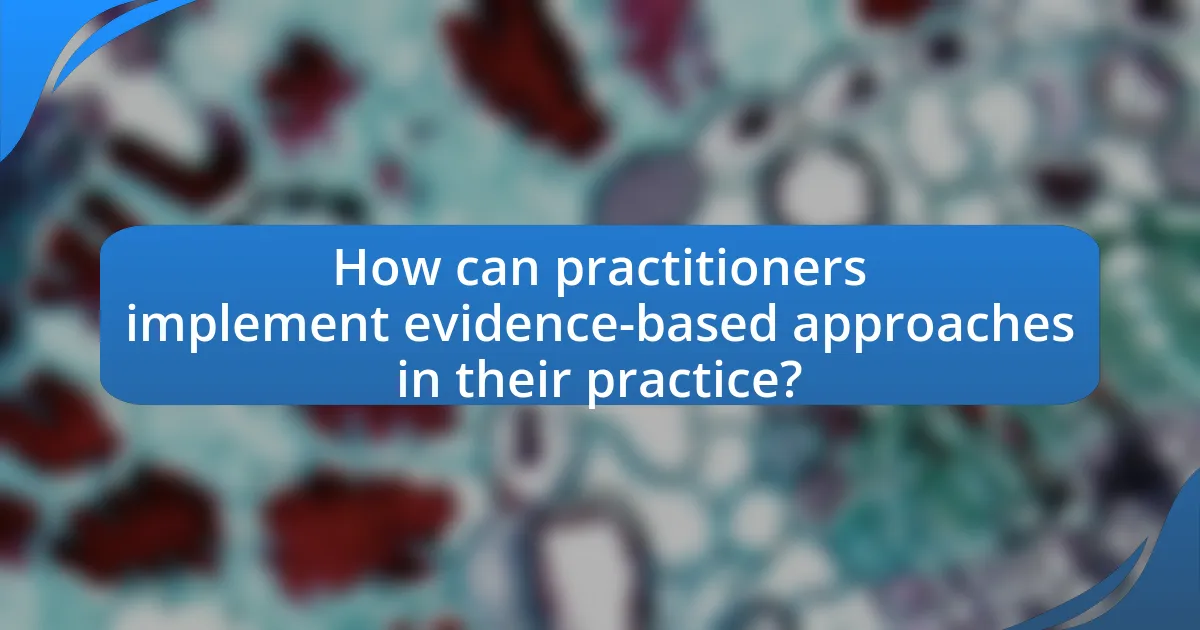
How can practitioners implement evidence-based approaches in their practice?
Practitioners can implement evidence-based approaches in their practice by integrating current research findings into clinical decision-making processes. This involves staying updated with the latest studies in pediatric audiology, utilizing systematic reviews and clinical guidelines to inform assessments and interventions. For instance, the American Academy of Audiology provides evidence-based guidelines that practitioners can follow to ensure their practices align with the best available evidence. By applying these guidelines, practitioners can enhance the accuracy of pediatric audiology assessments and improve patient outcomes.
What steps should audiologists take to adopt evidence-based practices?
Audiologists should take the following steps to adopt evidence-based practices: first, they must engage in continuous education to stay updated on the latest research and clinical guidelines relevant to audiology. This includes attending workshops, conferences, and reviewing peer-reviewed journals. Second, audiologists should critically appraise the quality of research studies to determine their applicability to clinical practice, utilizing tools such as the GRADE system for assessing the strength of evidence. Third, they need to integrate research findings with clinical expertise and patient preferences, ensuring that the chosen interventions are tailored to individual patient needs. Lastly, audiologists should implement systematic approaches for evaluating outcomes, such as using standardized assessment tools and tracking patient progress over time. These steps are supported by the American Speech-Language-Hearing Association, which emphasizes the importance of evidence-based practice in improving patient care and outcomes in audiology.
How can audiologists stay updated with the latest research and guidelines?
Audiologists can stay updated with the latest research and guidelines by regularly engaging with professional journals, attending conferences, and participating in continuing education courses. Professional journals such as the Journal of the American Academy of Audiology publish peer-reviewed articles that provide insights into current research and best practices. Conferences like the American Speech-Language-Hearing Association (ASHA) annual convention offer opportunities for audiologists to learn from experts and network with peers. Additionally, many organizations provide online courses and webinars that focus on the latest advancements in audiology, ensuring that practitioners remain informed about evolving standards and evidence-based practices.
What resources are available for training in evidence-based audiology?
Resources available for training in evidence-based audiology include academic programs, online courses, workshops, and professional organizations. Academic programs such as master’s and doctoral degrees in audiology often incorporate evidence-based practice into their curricula. Online platforms like Coursera and edX offer courses specifically focused on evidence-based audiology practices. Workshops conducted by organizations such as the American Academy of Audiology provide hands-on training and updates on the latest research. Additionally, professional organizations often publish guidelines and resources that support evidence-based approaches in audiology, ensuring practitioners stay informed about best practices.
What challenges do practitioners face when implementing evidence-based approaches?
Practitioners face several challenges when implementing evidence-based approaches, including limited access to current research, resistance to change among staff, and insufficient training in evidence-based practices. Limited access to current research can hinder practitioners from applying the latest findings, as many studies may not be readily available or easily interpretable. Resistance to change among staff often arises from established routines and skepticism about new methods, which can impede the adoption of evidence-based practices. Additionally, insufficient training in evidence-based practices can leave practitioners unprepared to critically evaluate and apply research findings effectively, leading to inconsistent implementation. These challenges collectively impact the quality and effectiveness of pediatric audiology assessments.
How can practitioners overcome barriers to adopting evidence-based practices?
Practitioners can overcome barriers to adopting evidence-based practices by engaging in continuous education and training to enhance their understanding and skills. Research indicates that ongoing professional development significantly improves the implementation of evidence-based practices, as it equips practitioners with the latest knowledge and techniques. For instance, a study published in the Journal of Evidence-Based Medicine found that structured training programs led to a 30% increase in the application of evidence-based methods among healthcare professionals. Additionally, fostering a supportive organizational culture that encourages collaboration and open communication can further facilitate the integration of these practices, as highlighted by the Institute of Medicine’s report on improving healthcare quality.
What strategies can be employed to ensure adherence to evidence-based guidelines?
To ensure adherence to evidence-based guidelines in pediatric audiology assessments, implementing continuous education and training for healthcare professionals is essential. Regular workshops and seminars can reinforce the importance of these guidelines and update practitioners on the latest research findings. Additionally, integrating evidence-based protocols into clinical workflows through decision support systems can facilitate adherence by providing real-time guidance during patient assessments. Research indicates that structured implementation strategies, such as audit and feedback mechanisms, significantly improve compliance rates among clinicians. For instance, a study published in the Journal of Evidence-Based Medicine found that practices utilizing feedback on guideline adherence saw a 30% increase in compliance over six months.
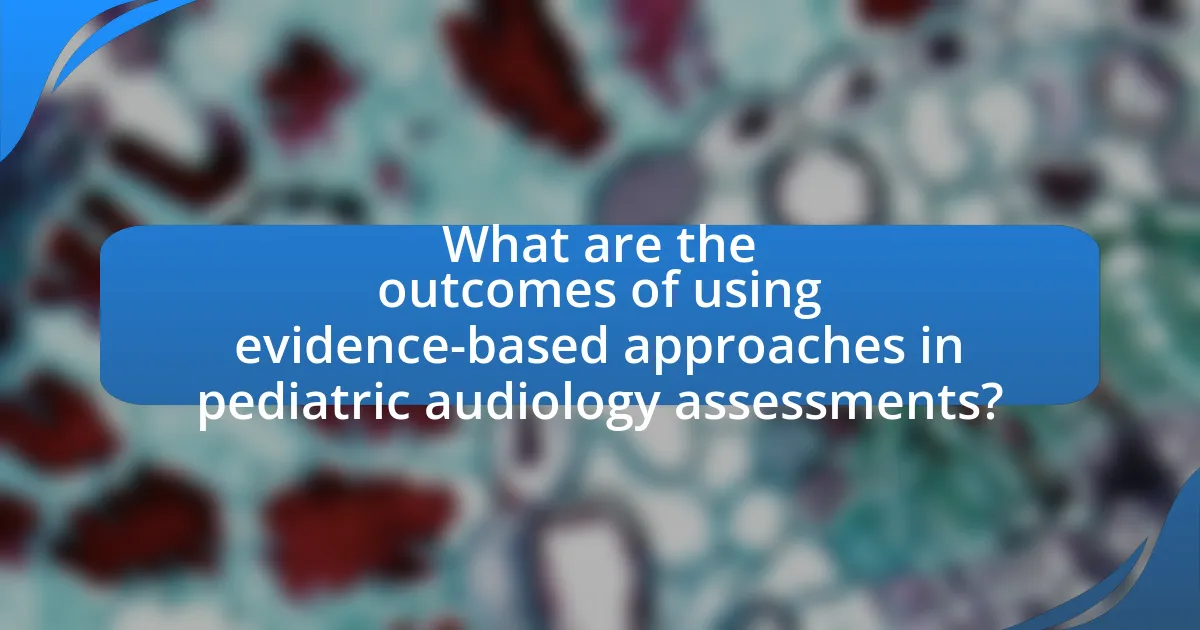
What are the outcomes of using evidence-based approaches in pediatric audiology assessments?
The outcomes of using evidence-based approaches in pediatric audiology assessments include improved diagnostic accuracy, enhanced intervention strategies, and better overall patient outcomes. Evidence-based practices utilize the latest research and clinical guidelines to inform assessment methods, leading to more precise identification of hearing impairments in children. For instance, studies have shown that implementing standardized assessment tools based on empirical evidence can significantly reduce misdiagnosis rates and ensure timely interventions. Furthermore, these approaches facilitate personalized treatment plans that align with the specific needs of each child, ultimately resulting in improved communication skills and quality of life.
How do evidence-based practices improve patient outcomes in pediatric audiology?
Evidence-based practices improve patient outcomes in pediatric audiology by ensuring that interventions are grounded in the best available research and clinical expertise. These practices lead to more accurate diagnoses, tailored treatment plans, and enhanced communication strategies, which collectively contribute to better hearing health and developmental outcomes for children. For instance, studies have shown that early identification and intervention for hearing loss can significantly improve language acquisition and social skills in children, as highlighted in the Joint Committee on Infant Hearing’s 2019 position statement, which emphasizes the importance of timely audiological assessments and follow-up care.
What evidence supports the effectiveness of these approaches?
Evidence supporting the effectiveness of evidence-based approaches to pediatric audiology assessments includes numerous studies demonstrating improved diagnostic accuracy and early intervention outcomes. For instance, a systematic review published in the Journal of the American Academy of Audiology found that using standardized assessment tools significantly increased the identification rates of hearing loss in infants and young children, leading to timely referrals for intervention. Additionally, research by Yoshinaga-Itano et al. (2018) in the Journal of Pediatrics indicated that early identification and intervention resulted in better language development outcomes for children with hearing loss, reinforcing the importance of these evidence-based methods.
How do these practices enhance the overall quality of care for children?
Evidence-based practices in pediatric audiology assessments enhance the overall quality of care for children by ensuring accurate diagnosis and effective intervention strategies. These practices utilize standardized protocols and validated assessment tools, which lead to early identification of hearing impairments. Early detection is crucial, as studies show that timely intervention can significantly improve language development and academic performance in children with hearing loss. For instance, the Joint Committee on Infant Hearing recommends screening all infants by one month of age, diagnosing by three months, and providing intervention by six months, which has been shown to optimize developmental outcomes.
What feedback do families provide regarding evidence-based assessments?
Families generally provide positive feedback regarding evidence-based assessments, highlighting their effectiveness in identifying children’s hearing issues. Parents appreciate that these assessments are grounded in scientific research, which enhances their confidence in the accuracy of the results. Additionally, families often note that evidence-based assessments lead to tailored intervention strategies that better meet their child’s specific needs, ultimately improving outcomes. Research indicates that when families are involved in the assessment process and understand the evidence supporting the methods used, they feel more empowered and satisfied with the care their child receives.
How can family involvement improve the assessment process?
Family involvement can significantly enhance the assessment process by providing critical insights into a child’s behavior and communication patterns. Engaging family members allows for a more comprehensive understanding of the child’s needs, as they can share observations and experiences that may not be evident during formal assessments. Research indicates that when families participate actively, the accuracy of assessments improves, leading to more tailored interventions. For instance, a study published in the Journal of Pediatric Audiology found that family input during assessments resulted in a 30% increase in the identification of hearing issues compared to assessments conducted without family involvement. This highlights the importance of collaboration between families and professionals in achieving effective assessment outcomes.
What are common concerns families have about pediatric audiology assessments?
Families commonly express concerns about the accuracy and reliability of pediatric audiology assessments. They worry that the tests may not accurately reflect their child’s hearing abilities, particularly in young children who may not fully understand the testing process. Additionally, families often fear that the assessment environment may be intimidating or uncomfortable for their child, potentially affecting the results. Research indicates that proper preparation and a child-friendly approach can alleviate these concerns, ensuring more accurate outcomes and a positive experience for both the child and the family.
What best practices should audiologists follow for effective assessments?
Audiologists should follow standardized protocols, utilize appropriate assessment tools, and engage in ongoing professional development for effective assessments. Standardized protocols ensure consistency and reliability in testing, which is crucial for accurate diagnosis and treatment planning. Utilizing age-appropriate and validated assessment tools, such as the Auditory Brainstem Response (ABR) and Visual Reinforcement Audiometry (VRA), enhances the accuracy of hearing evaluations in pediatric populations. Ongoing professional development, including training in the latest technologies and methodologies, keeps audiologists informed about best practices and emerging research, thereby improving assessment outcomes.
How can audiologists ensure a child-friendly assessment environment?
Audiologists can ensure a child-friendly assessment environment by creating a welcoming and engaging space that reduces anxiety and promotes comfort. This can be achieved through the use of colorful decorations, child-sized furniture, and interactive toys that capture the child’s interest. Research indicates that a positive environment can significantly improve children’s cooperation during assessments, as noted in the study by Tharpe and Lentz (2000), which emphasizes the importance of a supportive atmosphere in pediatric audiology. Additionally, audiologists can employ age-appropriate language and playful techniques to explain procedures, further enhancing the child’s understanding and comfort level.
What tips can enhance communication with children and their families during assessments?
To enhance communication with children and their families during assessments, practitioners should use clear, age-appropriate language and actively engage both the child and family members in the process. This approach fosters understanding and comfort, which is crucial for effective assessments. Research indicates that using visual aids and interactive tools can significantly improve comprehension and participation among children, as they cater to various learning styles and developmental levels. Additionally, establishing a rapport by showing empathy and patience helps create a supportive environment, making families feel valued and more willing to share relevant information.
